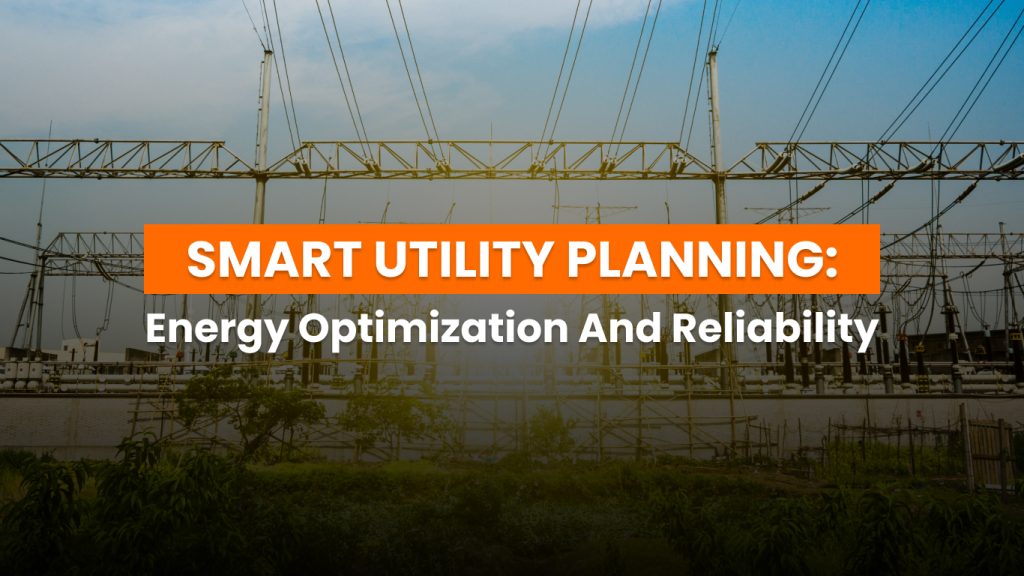Introduction
In an era of rising electricity demand and renewable energy growth, utilities are embracing smart utility planning to optimize energy resources. Smart utility planning means using data-driven tools and forward-looking strategies to ensure electricity is delivered reliably and affordably. By leveraging energy optimization software and advanced analytics, utilities can highlight solutions for delivering reliable, low-cost power when and where it’s needed. This approach balances the grid’s supply and demand, integrates new technologies, and prepares utilities to meet future needs without compromising
The Need for Smarter Utility Planning
Electric grids are becoming more complex as we add solar, wind, and battery storage alongside traditional power plants. Customers—from homeowners to large data centers—expect uninterrupted power even as consumption patterns change. For instance, U.S. electricity demand is projected to grow up to 20% by 2030, partly due to electrification (like EVs) and new industries. Peak power loads could increase 70–110% by 2040, according to McKinsey. This surge, combined with the variability of renewable generation, means utilities must plan smarter to avoid shortfalls during extreme weather or peak periods.
Traditional planning methods often relied on steady demand growth and fully dispatchable (on-demand) generation. Today, utilities face the challenge of intermittent resources (like solar that only produces in the daytime) and more dynamic demand. Smart planning addresses this by analyzing vast data—weather forecasts, consumption patterns, distributed generation output—and optimizing resource use in real time. Modern energy management platforms (for example, NextEra’s 360™ software) provide real-time analysis, custom planning, and optimization features to help utilities maximize renewable assets and meet sustainability goals. In practice, this means a utility can forecast a solar farm’s afternoon output, anticipate an evening surge in demand, and schedule fast-reacting resources (like battery storage or gas peaker plants) to fill the gap efficiently.
Forward-thinking power companies are already implementing smart planning through Integrated Resource Plans (IRPs). An IRP is a long-term roadmap that maps out how a utility will supply power over 10–20+ years. For example, PacifiCorp’s 2025 IRP outlines adding about 2,400 MW of solar, 2,270 MW of wind, and 1,680 MW of battery storage by 2030. By planning these additions, they aim to meet future demand and replace older coal plants, ensuring reliability. PacifiCorp expects its coal and gas generation to drop from 54% of its energy mix today to 26% by 2031, while wind and solar rise to 57%. This demonstrates how smart planning integrates renewable energy and storage at scale.
Tools and Strategies for Energy Optimization
Modern utility planning revolves around energy optimization—making the best use of available resources at the lowest cost. Key strategies and tools include:
- Advanced Analytics & AI: Utilities use predictive algorithms to anticipate demand spikes and renewable output. AI can process weather data, grid sensor readings, and consumption trends to recommend optimal dispatch of resources. For example, an energy optimization platform might suggest charging community batteries when excess solar power is available at noon, then discharging them during the evening peak to avoid firing up an expensive gas turbine. These analytics improve operational efficiency and reduce costs by recovering “missing megawatts” from existing assets (i.e., using every asset to its fullest).
- Demand Response and Load Shaping: Also known as “Reshape” strategies, these involve adjusting when and how consumers use energy. Utilities might offer programs that incentivize customers to shift heavy usage (like industrial processes or EV charging) to off-peak times. By reshaping demand curves, utilities can flatten extreme peaks, requiring less standby power. This not only lowers strain on the grid but also saves money for both the utility and consumers through improved efficiency.
- Distributed Energy Resources (DERs) Integration: Rooftop solar panels, solar energy farms, wind turbines, and battery systems are being connected across the grid. Smart planning means anticipating these resources’ output and strategically placing them. For instance, installing community battery banks in neighborhoods can provide localized backup power and help smooth out solar fluctuations. Some utilities are investing heavily in DERs; PacifiCorp, as noted, plans thousands of MW of local wind, solar, and storage. By incorporating DERs, utilities reduce reliance on distant power plants and improve resilience.
- Scenario Planning and Risk Management: Utility planners now stress-test their grids against various scenarios: heat waves, cold snaps, cloudy weeks, fuel supply disruptions, etc. Using sophisticated simulation tools, they identify weak points and create contingency plans. The outcome might be building additional fast-ramping generation (like quick-start natural gas engines or microgrids with storage) to cover worst-case peaks, or reinforcing transmission lines to import power from other regions when local supply is tight. This kind of “what-if” analysis is a core part of smart utility planning – ensuring that even if one resource is down or demand is unexpectedly high, the lights stay on.
Integrating Renewables and Ensuring Reliability
One hallmark of smart utility planning is the integration of renewable energy without sacrificing reliability. Renewable sources like solar and wind are clean and increasingly cost-effective, but their variability is a challenge. Here’s how smart planning addresses it:
- Diverse Supply Mix: Planners maintain a balanced generation portfolio. While expanding renewables, they also keep dispatchable sources (like natural gas plants) and emerging technologies in the mix. Natural gas, in particular, is often cited as critical for reliability – it’s affordable, quick to ramp up, and can fill gaps when renewables lag. The U.S. has over 2,000 natural gas power plants today providing on-demand energy, with more planned to meet rising demand. Smart plans leverage gas peaker plants judiciously, using them only when needed (e.g. a wind lull at dusk) while maximizing cheaper renewable generation at other times.
- Energy Storage Deployment: Batteries and other storage technologies are game-changers for reliability. Large-scale battery storage systems can absorb surplus power (say, a midday solar glut) and release it during evening peaks or emergencies. Utilities are rapidly adding batteries; in fact, nearly 4 GW of battery storage were added in a single quarter of 2023 in the U.S., indicating the scale of this trend. Storage not only provides backup power but also reduces reliance on spinning reserves (power plants kept idling for emergencies) by instantly reacting to grid fluctuations. Smart planning often pairs new renewable projects with storage – for example, building a solar farm with an adjacent battery bank so that excess noon energy is stored for night usage.
- Grid Modernization (Smart Grid): Upgrading grid infrastructure is another facet of smart planning. This includes deploying smart meters, automated switches, and real-time monitoring systems. A smart grid can isolate faults (improving outage response) and dynamically reroute power, enhancing reliability. It also enables two-way power flow, which is essential when distributed solar panels or home batteries start feeding energy back to the grid. Utility planners ensure new control technologies and communication networks are in place so the grid can handle these modern complexities gracefully.
- Microgrids and Decentralization: Rather than relying solely on giant central power plants, smart planning embraces microgrids – localized grids that can operate independently if needed. Critical facilities (hospitals, data centers, military bases) or remote communities might have their own microgrid with solar panels, a linear generator or small turbine, and batteries. In normal conditions, these microgrids connect to the main grid; during outages or grid stress, they can island themselves and keep running. Utility planners incorporate microgrids to bolster overall system resilience. For example, the CSA Group’s Distributed Energy Resource lab in Ohio is working on microgrid tech and integration, underlining industry focus on decentralized solutions
Benefits of Energy Optimization for Utilities and Consumers
Investing in smart utility planning yields significant benefits:
- Cost Savings: Optimizing energy usage means power comes from the lowest-cost resources available at any time. By avoiding unnecessary peaker plant runs and improving efficiency, utilities save fuel and operational costs. These savings ultimately flow to consumers through lower rates. Additionally, preventing outages (which can be very costly to fix and incur regulatory penalties) is financially prudent. Western Resource Advocates note that renewable energy brings greater price stability to customers and cuts fuel cost risks. In short, energy optimization minimizes waste and leverages cheap power, keeping electricity bills in check.
- Reliability and Resilience: A smartly planned grid experiences fewer and shorter outages. Proactive maintenance (guided by data from smart sensors) can fix issues before they cause blackouts. Diverse resources mean even if one source falters (like a gas fuel supply issue or a cloudy week affecting solar), others can compensate. For example, during the Winter Storm Elliott in 2022, some regions had power issues when gas supply froze. Utilities learned from this and are reinforcing infrastructure to ensure fuel supply and alternate generation are available during extremes. With better planning, critical services stay online and communities are safer during disasters.
- Environmental Gains: Smart planning often aligns with clean energy goals. By optimizing when fossil-fueled plants run, utilities can reduce emissions (only firing gas plants when absolutely needed and turning them off when renewables suffice). Over the long term, integrated planning paves the way to meet climate targets. For instance, Michigan’s DTE utility, in its CleanVision plan, aims for net-zero carbon by 2050 by retiring coal plants, adding 15,000 MW of solar and wind, and building 1,800 MW of energy storage. These steps, identified in their smart planning process, lead to enormous emissions cuts while keeping the grid reliable. Smart utility planning thus serves both economic and environmental sustainability.
- Adaptability for the Future: Perhaps the biggest benefit is making the grid future-proof. The energy landscape is evolving with new technologies like electric vehicles, smart appliances, and possibly green hydrogen production coming online. Smart planning today creates a flexible grid that can accommodate these future loads and resources. Utilities that optimize now will handle tomorrow’s solar energy boom, EV charging surge, or next-generation tech far more gracefully. This avoids scrambling later or making costly last-minute investments.
Conclusion
Smart utility planning is emerging as the blueprint for power companies facing the dual challenge of growing demand and clean energy integration. By focusing on energy optimization, utilities ensure that every electron is generated and delivered in the most efficient way possible. Advanced tools, whether software platforms or grid-scale batteries, are enabling a new level of insight and control over the electric system. The result is a win-win: customers get reliable, affordable electricity, and utilities meet sustainability targets while maintaining a stable grid.As the case studies show—from PacifiCorp’s renewables-rich plan (utilitydive.com) to DTE’s coal-to-solar shift —proactive planning is key to a smooth energy transition. By investing in smart grids, diverse resources, and robust analytics, utilities can navigate uncertainties like extreme weather or market changes. Smart utility planning truly optimizes energy use, ensuring that as we build a cleaner energy future, the lights stay on and costs stay under control.




